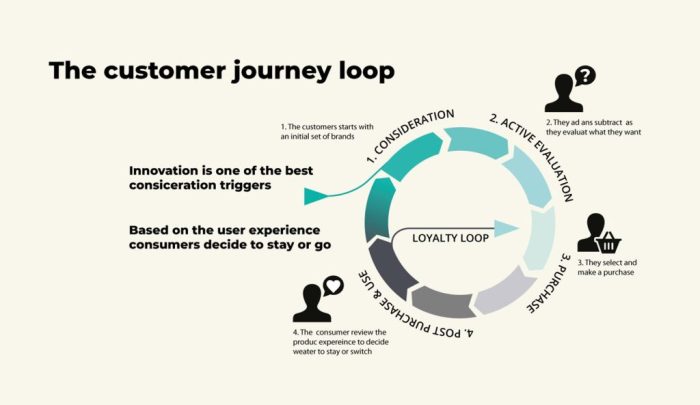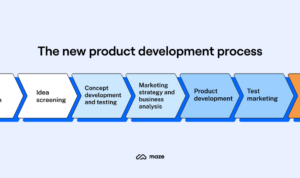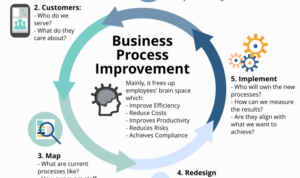Understanding Customer Journey sets the stage for unraveling the intricacies of how businesses can enhance customer experiences through a well-crafted journey. From defining the journey to personalizing it, this exploration delves deep into the realm of customer satisfaction.
As we embark on this journey, let’s uncover the secrets to creating lasting connections with customers and transforming ordinary interactions into extraordinary moments.
Introduction to Customer Journey
A customer journey refers to the complete sum of experiences that customers go through when interacting with a company and brand. It is crucial for businesses to understand the customer journey as it helps in identifying pain points, optimizing touchpoints, and improving overall customer satisfaction.
The key stages of a typical customer journey include awareness, consideration, purchase, retention, and advocacy. During the awareness stage, customers become aware of the brand or product. In the consideration stage, they evaluate different options before making a purchase. The purchase stage involves the actual transaction, while retention focuses on keeping customers engaged and satisfied. Finally, advocacy involves customers becoming loyal fans and recommending the brand to others.
Examples of Impactful Touchpoints
- Website Visit: A well-designed and user-friendly website can greatly influence a customer’s decision to explore further or make a purchase.
- Social Media Interaction: Engaging with customers on social media platforms can create a sense of community and loyalty.
- Customer Service: Positive interactions with customer service representatives can leave a lasting impression and build trust.
- Email Marketing: Personalized and relevant email campaigns can nurture leads and encourage repeat purchases.
Mapping the Customer Journey

When it comes to mapping out a customer journey, the process involves visualizing the steps a customer takes from the initial awareness of a product or service to the final purchase and post-purchase experience. This mapping helps businesses understand the touchpoints and interactions customers have with the brand throughout their journey.
Steps to Create a Customer Journey Map
- Identify customer personas: Start by creating detailed profiles of your target customers to understand their needs, preferences, and behaviors.
- Artikel touchpoints: Map out all the potential interactions customers may have with your brand, including online and offline channels.
- Plot the customer journey stages: Divide the customer journey into key stages such as awareness, consideration, decision, and retention.
- Identify pain points and moments of delight: Highlight areas where customers may face challenges or have positive experiences to improve overall satisfaction.
- Gather feedback: Use customer surveys, interviews, and data analysis to validate and refine the customer journey map.
Importance of Identifying Customer Pain Points and Moments of Delight
Customer pain points represent areas where customers may encounter difficulties, frustrations, or obstacles in their journey. By identifying and addressing these pain points, businesses can improve customer satisfaction, loyalty, and retention. On the other hand, moments of delight are opportunities for businesses to exceed customer expectations and create memorable experiences that foster brand advocacy and positive word-of-mouth. Recognizing and enhancing these moments can differentiate a brand from its competitors and build long-term relationships with customers.
Personalizing the Customer Journey: Understanding Customer Journey

Personalizing the customer journey is crucial in creating a unique and tailored experience for each individual customer. By understanding and adapting to customer preferences, businesses can increase customer satisfaction, loyalty, and ultimately drive revenue.
Benefits of Personalizing the Customer Journey
- Improved Customer Engagement: When customers feel like a brand understands their needs and preferences, they are more likely to engage with the brand and make repeat purchases.
- Increased Customer Loyalty: Personalization creates a sense of loyalty as customers feel valued and appreciated by the brand.
- Higher Conversion Rates: Tailoring the customer journey based on individual preferences can lead to higher conversion rates as customers are more likely to make a purchase when they receive personalized recommendations.
Strategies for Tailoring Experiences Based on Customer Preferences
- Utilize Customer Data: Collect and analyze data related to customer behavior, purchase history, and preferences to personalize the customer journey.
- Implement Personalized Recommendations: Use customer data to provide personalized product recommendations, content, and offers to enhance the customer experience.
- Create Segmented Campaigns: Segment customers based on their preferences and behavior to deliver targeted campaigns that resonate with each segment.
Role of Data and Analytics in Personalizing the Customer Journey
Data and analytics play a crucial role in personalizing the customer journey by providing insights into customer behavior and preferences. By leveraging data, businesses can create targeted and relevant experiences that meet the individual needs of customers. Through data-driven personalization, businesses can build stronger relationships with customers and drive long-term loyalty.
Omnichannel Customer Journey
An omnichannel customer journey refers to the seamless and integrated experience a customer has across multiple channels when interacting with a brand. This approach ensures that the customer receives a consistent and personalized experience regardless of the channel they use, whether it’s online, in-store, or through social media.
Comparing Omnichannel vs. Multichannel Customer Experiences, Understanding Customer Journey
While multichannel customer experiences involve interactions across various channels, these channels often operate independently of each other. On the other hand, omnichannel experiences are interconnected, providing a unified and consistent experience for the customer. The key difference lies in the integration and cohesion of the customer journey.
- Omnichannel: Offers a seamless experience across all channels
- Multichannel: Channels operate independently
- Omnichannel: Focuses on integration and cohesion
Challenges and Benefits of Implementing an Omnichannel Approach
Implementing an omnichannel approach comes with its own set of challenges and benefits. While it requires a significant level of coordination and investment, the rewards can be substantial in terms of customer satisfaction and loyalty.
- Challenges:
- Integration of data from various channels
- Consistent messaging and branding across platforms
- Providing a seamless experience for customers
- Benefits:
- Improved customer satisfaction and loyalty
- Increased sales and revenue
- Better understanding of customer behavior and preferences





